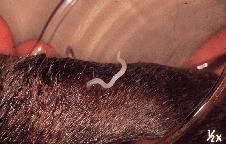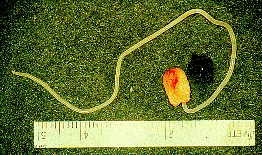| Guinea
Worm |
 |
|
| |
| Causative Agent |
-
Guinea worms (Dracunculus) are
nematodes that parasitize areas
beneath the skin of the legs of fur-bearing mammals throughout North
America.
-
In North America, two
species, Dracunculus insignis and D. lutrae, are
recognized under the common name of guinea worm.
|
| Images |
|
Click on
images to enlarge. |
 |
 |
|
| Distribution |
|
Geographic: |
-
D. insignis
has been reported throughout
North America.
-
D. lutrae
has only
been reported in the east-central portion of the continent.
|
|
Seasonality: |
-
Transmission of Dracunculus worms may occur during only a few
weeks of the year or throughout the year depending on the
diet of the
definitive host species.
|
|
| Hosts, Transmission and Life
Cycle |
-
Female worms are slender and whitish and can be up to 28 cm in length;
males appear dark, extremely slender and usually 1.5 to 4 cm long.
-
Female worms are located
between the skin and muscle on the thorax, abdomen, groin
and legs of hosts.
-
Male worms, which also occur
beneath the skin, are rarely found outside of the thorax,
abdomen and groin.
-
Pregnant female worms occur
just under the skin in the legs. This causes the development
of a blister in the skin of the host that eventually
ruptures, forming an
ulcer.
-
Larvae leave through the
ulcer when the affected area is
immersed in water.
-
Intermediate hosts,
Cyclops sp. (a small freshwater
crustacean), ingest the larvae and
here they develop until they are infective to the
definitive host.
-
Some fish or frogs may
ingest infected Cyclops and serve as
reservoir hosts for the parasite.
-
The
definitive host drinks water containing parasitized Cyclops or ingests infected
reservoir hosts and Dracunculus larvae are released into the intestinal tract.
-
Larvae then penetrate the intestine and migrate through the body cavity
to
connective tissues of the abdomen, thorax and groin. After mating, male worms remain in this
location and fertilized females migrate towards the legs.
-
After production of larvae, worms may die and be absorbed by the
definitive host.
|
|
| Signs and Symptoms |
-
Infected animals may raise affected legs off of the ground and
occasionally scratch at the site of blisters or
ulcers. Hair may be lost and skin
damage may occur.
-
Ulcers
often heal quickly after the female worm has released the larvae and
has died.
-
Guinea worms are not a significant mortality factor as their
infections are generally limited to the
subcutaneous spaces of the legs.
-
The quality of the pelt is
not impaired by the worm's presence, for the
ulcerations occur only on the legs.
|
| Meat Edible? |
-
Since only the limbs are affected, the remainder of the carcass should be
edible.
-
Dogs and cats are susceptible to Dracunculus infection and, as
such, should not be allowed to scavenge dead fish or frogs which may
contain infected larvae.
|
| Human Health Concerns and
Risk Reduction |
-
Although humans in Africa are susceptible to other
species of
Dracunculus, humans are not able to contract D. insignis and D. lutrae
and therefore, these species of guinea worms are not of public health
significance.
|
| Samples for Diagnosis |
-
Infection with Dracunculus worms can be confirmed by finding and
identifying adult worms in the
subcutaneous space of the legs.
-
Finding a Dracunculus
worm is more likely if both the pelt and carcass are examined.
|
| Further Reading |
|
|
|
|


